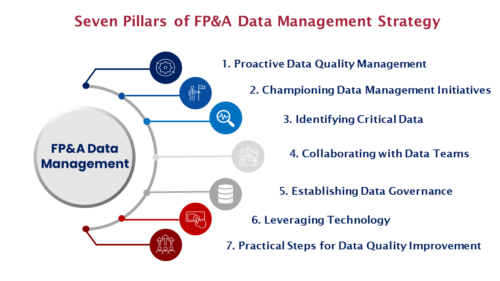
Navigating the future with predictive planning and forecasting
Planning for uncertainty In today’s fast-paced business environment, uncertainty is a constant challenge. Traditional planning…

Financial Planning and Analysis (FP&A) is pivotal in today’s dynamic business environment, facilitating data-driven decision-making. However, the 2023 FP&A Trends Survey highlights a critical challenge: FP&A professionals spend nearly half their time on low-value data-related activities, hampering strategic analysis opportunities.
This article explores how FP&A’s data strategies can bolster decision-making and business success, particularly through identifying, validating, and monitoring key drivers and assumptions.
FP&A departments face diverse challenges: gaining executive support, handling complex data integrations, and managing growing data volumes. The 2023 FP&A Trends Survey highlights that 33% of organizations need consistent data definitions, hindering effective data consolidation. Perhaps more concerning is the finding that 36% of organizations need a reliable data source, which adds complexity to data analysis and decision-making.
To overcome these challenges, strategic solutions are imperative. Centralizing data management systems, such as data lakes or warehouses, can be transformative, providing a unified platform for integrating various datasets and enhancing data accessibility and consistency.
Today, FP&A goes beyond just handling data; it actively shapes data strategies. This vital role includes identifying crucial data needs, validating sources, and ensuring data quality.
FP&A professionals are instrumental in Scenario Analysis, furnishing accurate data for informed decision-making. They continuously refine models, enabling organizations to swiftly adapt to market shifts.
FP&A takes the lead in driving agile and data-informed decisions. Leveraging identified key business drivers and assumptions, FP&A shapes instantly adaptable models critical for Scenario Planning. By collaborating with data scientists and IT teams, FP&A professionals ensure data strategies remain refreshed to align dynamically with real-time data. This proactive leadership is essential for maintaining a competitive edge.
The FP&A approach to data management is founded on seven key pillars (see Fig. 1), each vital for crafting a robust and effective data strategy:

Figure 1: Seven pillars of data management strategy
FP&A professionals must:
The above five actions enable FP&A professionals to work with the ‘right’ data, which promotes agile forecasting and insightful decision-making.
Facing escalating analysis demands, Sella Group, a prominent financial services firm, embarked on a transformative journey to enhance its data-driven decision-making capabilities. Recognizing the critical need for streamlined processes and insightful analytics, Sella Group implemented the Board Intelligent Planning Platform.
Under the leadership of Alessandro Basile, Head of Group Planning, Execution, and Control, Sella Group embraced a new organizational model. Basile summarized the model as ‘Board as a platform,’ integrating reporting, analytics, dashboarding, planning, and business modeling processes across the Group’s 20 companies into a single platform.
This adoption enabled the seamless integration of performance management and Business Intelligence functions, empowering teams to leverage real-time data for informed decision-making. The results were remarkable: significant improvements in operational efficiency and customer service metrics were witnessed across the organization.
This success underscores the indispensable role of FP&A in driving business excellence through effective data management, cementing its position as a strategic asset in the organization’s quest for success in a data-driven landscape.
The FP&A landscape is set for a significant shift due to the rise in AI and ML technologies. These innovations can become integral to FP&A processes as we enter an era of Predictive and Prescriptive Analytics. The 2023 FP&A Trends Survey reveals a concerning trend: only 6% of organizations base every decision on data, a slight decline from previous years. This trend underlines the urgency to embrace these new technologies, gain deeper insights, and enhance strategic decision-making.
In FP&A, data is the rhythm, and technology is the stage. Integrating these elements is not just operational but a strategic imperative for performance in the business world.
Integrating FP&A and data management is a strategic requirement in modern business. The 2023 FP&A Trends Survey shows a growing trend toward data-centric decision-making. High-quality data forms the backbone of an effective FP&A department, enabling enhanced decision-making and Strategic Planning. The FP&A teams become crucial to organizational success and resilience by embracing these trends and best practices.